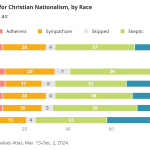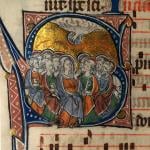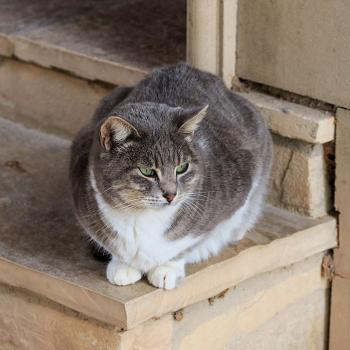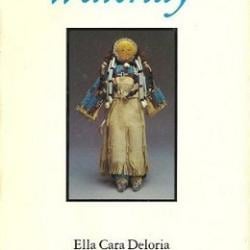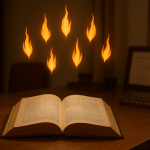Today’s post is a mix of methodological and personal musings, thinking about how our work as historians should shape our practices as Christians (and vice versa). Some of this grows out of thinking about silence– not just because with two little ones at home, silence is in short supply, but because many of my recent and ongoing research projects grapple with archival silences: an article on dancing mania and archival silencing, my book project on emotion and lay communities in medieval York, a new project on Saami encounters with medieval Christians, and a conference response on new directions in dance history. Each of these considers the problem of voices missing from the historical archive and how we might hear these voices when they don’t survive in traditional textual forms. How can we do history that gives voice to the voiceless?
Hearing through Historical Silences
I’m certainly not the first historian to think through questions of archival silence or archival shouting– the absence of voices from an archive, or the amplification of other voices. Michel-Rolph Trouillot’s class work Silencing the Past: Power and the Production of History explores how archives often hide, silence, or simply exclude voices from their historical record, shaping what we consider history in their absence. In the inverse, Karin Wulf recently explored how some archives not only silence voices but also help others to be heard more loudly than the experience of the past merits, creating what she terms “archival shouting.” The challenge of the historian is to amplify the voices that are silenced (or just not preserved at all) while bringing the shouted voices back to a proportionate volume. Only in a rightly balanced chorus of voices do we clearly see and understand the past, both its events and what it was like to live in it.
In my recent research, I’ve thought about several methodological paths forward which help answer this question. My forthcoming work on dancing mania and my new book project on Saami/Christian encounters in medieval Scandinavia propose that we might be able to fill these silences by “reading” dancing bodies. Bodies and movement communicate and create meaning– in our modern context, we “read” moving bodies all the time, whether gestures that communicate emotions, processions and assemblies that make political or social points, or dance in specific times and places as a way of building community or of protesting. It’s not hard for us to understand what a wedding dance communicates, or a crowd storming a field at the end of a sporting event, and yet we often ignore descriptions of movements like these when trying to understand the past. Paying attention to and reading these moving bodies through the frameworks of their own culture and society helps us hear the people in these moving groups. For example, in thinking about what the dancing mania of the Middle Ages meant to the people participating in and observing them, the bodies of the dancers, meant to be seen and heard, act as speaking texts. By considering the time, place, and people who danced, we can “hear” the voices of the dancers.
Reading dancing bodies points us towards one possible methodological path forward in the face of archival silences; the practice of dance itself hints at another path. Dance, particularly in the premodern communities I study, was a way to build, define, and strengthen communities. Sometimes, like in the case of parish dances, dance helped strengthen the bonds between neighbors. Sometimes, like in encounters between Europeans and Saami, dance was used to define theologies and social orders, insiders and outsiders. Sometimes attempts at stopping dance were attempts at stopping protests against those in power, whether clerical or civic officials. Yet in all of these cases, dance helped to order and build communities. In studying dance and tracing out the communities it built or challenged, we can often hear the members of those communities who do not appear as clearly in other sorts of records. It’s because of communal networks created (within, against, and in spite of) dominant socio-political frameworks that we can find, study, and analyze the dancers of the premodern era. And perhaps it behooves us to remember that we need those same sorts of communal networks (within, against, and in spite of our own academic, social, denominational, or political silos) in order to see, hear, and learn from each other. In short, communities– both historically and in the present– give us a way to counter the archival silences that cloud our perspectives on the past.
Listening and the Communion of Saints
If community is an answer for addressing archival silences, perhaps the idea of the “communion of saints” offers us, as Christians and historians, another path towards rightly hearing the chorus of historical voices we seek. Another classic work, John Bossy’s Christianity in the West, 1400-1700, provides a survey of Christianity before the early modern Reformations and a striking way to think about this communion of saints. In Bossy’s telling, prior to the sixteenth century, Christianity was not a set of “isms” or beliefs, but “a body of people”– a community more than anything else (vii, 171). For medieval believers, their communion of saints was expansive. It included those in their parishes, those who died during their lifetimes, and those who would follow them. It was not bound by the living, but inclusive of the dead. Those in the communion of saints who came before were as present as those who lived next door.
After the early modern Reformations, as Bossy points out, this immediacy of presence disappeared from frameworks for understanding the church and Christianity. Christianity became more about bodies of belief rather than physical bodies, and while this brought many gains, it also brought many losses. To return to our archival framework, focusing on a body of beliefs brought an emphasis on texts (catechisms, creeds, liturgies, or confessions), which created a sort of “archival shouting” in which ideas mattered more than people.
Clearly, ideas and belief do matter- but I wonder if part of countering the archival silences that hide the voices of the laity, of the marginalized, of the majority of the church (in any given setting, in the global context, and through the thousands of years of church history) is returning to this idea of a body of believers as the way to view the church. Thinking about our “archive” as Christians more expansively, as an archive of believers rather than of books, might help us better hear the voices of those who came before us, in ways that make us both better historians (able to better present, understand, and engage the past) and better Christians (able to better present, understand, and serve in the global body of Christ as opposed to a denominational archive or belief).
Honoring Absent Voices
Maybe part of why this idea of better listening to silenced voices in the archives has resonated so much with me lately is because of the loss of some voices from my own community, whether from friends leaving academia because of ongoing cuts to universities and funding or because of the loss of a friend to cancer this spring. I know these voices– their scholarship, their wisdom, their humor, their faith– and yet, those who come after me will not, or will at best know them in part rather than in full. This is a loss, both to me personally and to those who could learn from them but will not have the chance to do so if we only listen to the voices that are preserved most loudly.
To be able to hear and honor these absent voices, in our lives, in our churches, and in history writ broad, we need to first be embedded in community. We then need to work to honor, record, and remember those in our community, for if we’re not practicing looking for and listening to these voices in the present, we are going to struggle to do so historically. We need to let the medieval framework of the communion of saints– in which quiet or absent voices are just as present as embodied ones– shape our historical work and our approach to creating archives. By letting this framework speak into our lives and work, we are reminded that no one is insignificant: every voice (maybe even especially the ones that only leave whispers in the historical record) contributes to our communities in substantial ways. And no voice is completely beyond reach or completely lost: as long as we are willing to build communities that remember, that listen, and that honor the dignity and worth of each person, we can find creative ways to translate and hear past the silence of the archives to the chorus of voices they contain.


